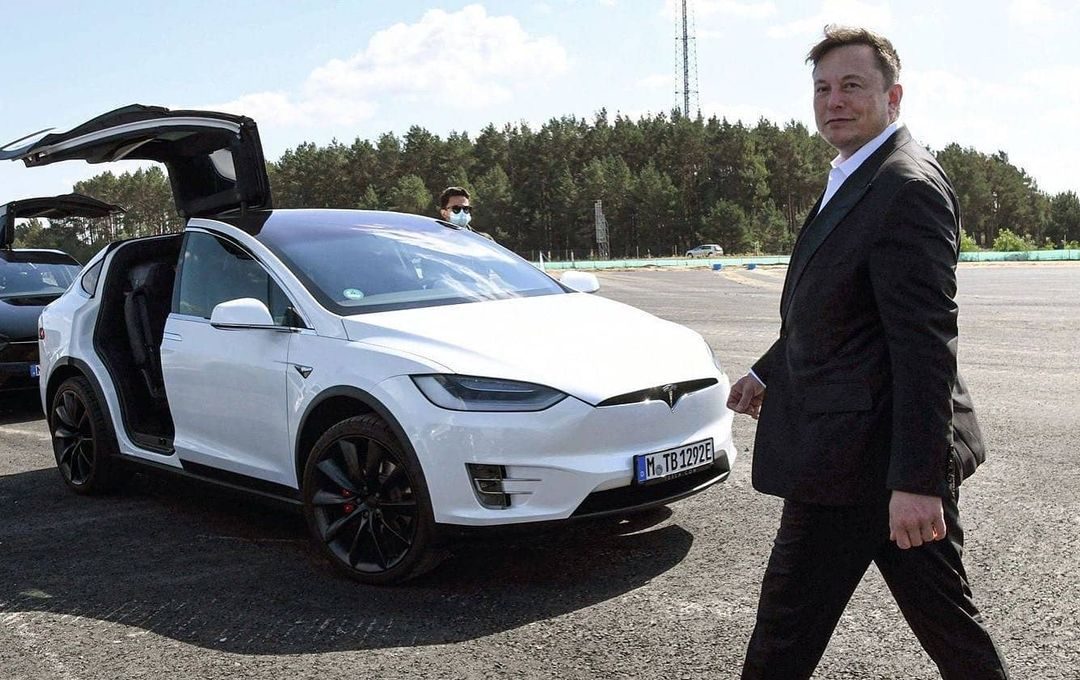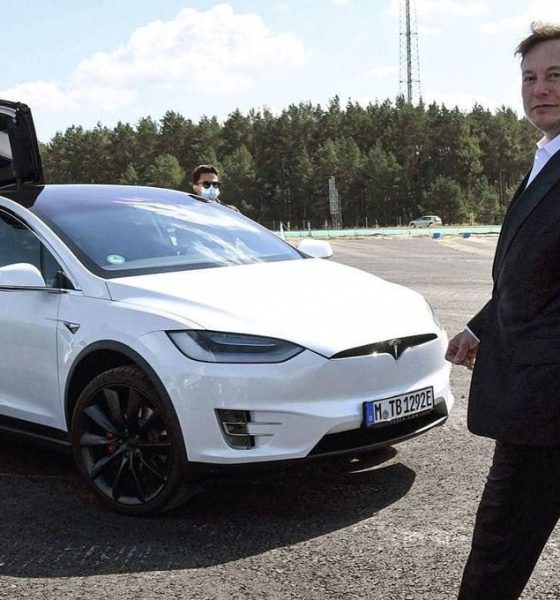Tesla CEO Elon Musk has landed in Germany for a “technical” visit to Giga Berlin, the European production facility Tesla plans to launch later this year. During an interview with local media, Musk stated that he hopes production can begin by the end of 2021.
According to Jörg Steinbach, the Minister of Economics, Labor, and Energy for the State of Brandenburg, his team was informed by Tesla directly last week that Musk would be visiting Germany on May 14th. This meeting didn’t take place, but Musk did arrive in Germany yesterday, May 16th, according to his plane tracker. Musk left London for Berlin Brandenburg Airport and arrived in Germany after a quick, 76-minute flight.
Steinbach said the nature of the visit is “mainly technical” and that Musk has not scheduled meetings with either him or Dietmar Woidke, who is Brandenburg’s Minister-President.
We have been informed by @Tesla on Friday, May 14th, that a visit of @elonmusk of Grünheide was expected to happen. As the purpose of this visit is mainly technical in character political meetings with Ministerpräsident #Woidke or myself have not been scheduled. @Stk_Brandenburg
— Jörg Steinbach (@joergstb) May 16, 2021
After visiting Giga Berlin on Monday, Musk indicated that he hopes the site will be ready for production by the end of 2021.
“It looks like we could start production at the end of the year,” Musk said. “You can only build cars when all the parts are in place.”
Musk has visited Germany on two previous occasions, with his first appearance being in September 2020 and the second in November, where he personally interviewed engineering applicants who desired to work at Giga Berlin. The factory has encountered exceptional support from local politicians, including Steinbach and Woidke. Steinbach recently confirmed to Teslarati that the rumored production delays until early 2022 were not accurate and that he expected Tesla to begin producing vehicles in Germany as early as late-Summer.
Tesla CEO Elon Musk receives rockstar welcome in first visit to Giga Berlin
Tesla’s application for Giga Berlin continues to work its way through the approval process. Local sources indicate that it could take anywhere from 3-5 years for Tesla to gain ultimate approval, but this will not prevent the automaker from producing its vehicles at the facility. Ultimately, the deliberate process that is utilized by politicians to approve a project gives the government plenty of time to examine all of the implications of allowing a massive industrial project to operate in the region. The chances for rejection are extremely slim, even though the process will take several years to be finalized.
Musk commented on the process during the interview at the Giga Berlin site today.
“I think it would be better if there was less bureaucracy. On the other hand,” Musk continued, “more and more rules accumulate over time, and in the end, you can’t do anything.”
Elon continued
“On the other hand, more and more rules accumulate over time, and in the end you can’t do anything.”
But he is confident about Giga Berlin, “I think it will work well”
— Alex (@alex_avoigt) May 17, 2021
Tesla recently added plans for a battery cell plant to the application, increasing its production rate for the new, less expensive, but more effective 4680 battery cells. Tesla will not build this factory in time for the initial production phase in a few months and will instead depend on cells from its Kato Road cell manufacturing plant in Northern California.
Tesla said it expects Giga Berlin to begin limited production by the end of the year in its Q1 2021 Earnings Call Update Letter. Volume production at the plant is expected to begin in 2022, the company said.

News
Tesla China delivery centers look packed as 2025 comes to a close
Needless to say, it appears that Tesla China seems intent on ending 2025 on a strong note.

Tesla’s delivery centers in China seem to be absolutely packed as the final days of 2025 wind down, with photos on social media showing delivery locations being filled wall-to-wall with vehicles waiting for their new owners.
Needless to say, it appears that Tesla China seems intent on ending 2025 on a strong note.
Full delivery center hints at year-end demand surge
A recent image from a Chinese delivery center posted by industry watcher @Tslachan on X revealed rows upon rows of freshly prepared Model Y and Model 3 units, some of which were adorned with red bows and teddy bears. Some customers also seem to be looking over their vehicles with Tesla delivery staff.
The images hint at a strong year-end push to clear inventory and deliver as many vehicles as possible. Interestingly enough, several Model Y L vehicles could be seen in the photos, hinting at the demand for the extended wheelbase-six seat variant of the best-selling all-electric crossover.
Strong demand in China
Consumer demand for the Model Y and Model 3 in China seems to be quite notable. This could be inferred from the estimated delivery dates for the Model 3 and Model Y, which have been extended to February 2026 for several variants. Apart from this, the Model Y and Model 3 also continue to rank well in China’s premium EV segment.
From January to November alone, the Model Y took China’s number one spot in the RMB 200,000-RMB 300,000 segment for electric vehicles, selling 359,463 units. The Model 3 sedan took third place, selling 172,392. This is quite impressive considering that both the Model Y and Model 3 are still priced at a premium compared to some of their rivals, such as the Xiaomi SU7 and YU7.
With delivery centers in December being quite busy, it does seem like Tesla China will end the year on a strong note once more.
News
Tesla Giga Berlin draws “red line” over IG Metall union’s 35-hour week demands
Factory manager André Thierig has drawn a “red line” against reducing Giga Berlin’s workweek to 35 hours, while highlighting that Tesla has actually increased its workers’ salaries more substantially than other carmakers in the country.

Tesla Giga Berlin has found itself in a new labor dispute in Germany, where union IG Metall is pushing for adoption of a collective agreement to boost wages and implement changes, such as a 35-hour workweek.
In a comment, Giga Berlin manager André Thierig drew a “red line” against reducing Giga Berlin’s workweek to 35 hours, while highlighting that Tesla has actually increased its workers’ salaries more substantially than other carmakers in the country.
Tesla factory manager’s “red line”
Tesla Germany is expected to hold a works council election in 2026, which André Thierig considers very important. As per the Giga Berlin plant manager, Giga Berlin’s plant expansion plans might be put on hold if the election favors the union. He also spoke against some of the changes that IG Metall is seeking to implement in the factory, like a 35-hour week, as noted in an rbb24 report.
“The discussion about a 35-hour week is a red line for me. We will not cross it,” Theirig said.
“(The election) will determine whether we can continue our successful path in the future in an independent, flexible, and unbureaucratic manner. Personally, I cannot imagine that the decision-makers in the USA will continue to push ahead with the factory expansion if the election results favor IG Metall.”
Giga Berlin’s wage increase
IG Metall district manager Jan Otto told the German news agency DPA that without a collective agreement, Tesla’s wages remain significantly below levels at other German car factories. He noted the company excuses this by referencing its lowest pay grade, but added: “The two lowest pay grades are not even used in car factories.”
In response, Tesla noted that it has raised the wages of Gigafactory Berlin’s workers more than their German competitors. Thierig noted that with a collective agreement, Giga Berlin’s workers would have seen a 2% wage increase this year. But thanks to Tesla not being unionized, Gigafactory Berlin workers were able to receive a 4% increase, as noted in a CarUp report.
“There was a wage increase of 2% this year in the current collective agreement. Because we are in a different economic situation than the industry as a whole, we were able to double the wages – by 4%. Since production started, this corresponds to a wage increase of more than 25% in less than four years,” Thierig stated.
News
Tesla is seeing a lot of momentum from young Koreans in their 20s-30s: report
From January to November, young buyers purchased over 21,000 Teslas, putting it far ahead of fellow imported rivals like BMW and Mercedes-Benz.

Tesla has captured the hearts of South Korea’s 20s-30s demographic, emerging as the group’s top-selling imported car brand in 2025. From January to November, young buyers purchased over 21,000 Teslas, putting it far ahead of fellow imported rivals like BMW and Mercedes-Benz.
Industry experts cited by The Economist attributed this “Tesla frenzy” to fandom culture, where buyers prioritize the brand over traditional car attributes, similar to snapping up the latest iPhone.
Model Y dominates among young buyers
Data from the Korea Imported Automobile Association showed that Tesla sold 21,757 vehicles to the 20s-30s demographic through November, compared to BMW’s 13,666 and Mercedes-Benz’s 6,983. The Model Y led the list overwhelmingly, with variants like the standard and Long Range models topping purchases for both young men and women.
Young men bought around 16,000 Teslas, mostly Model Y (over 15,000 units), followed by Model 3. Young women followed a similar pattern, favoring Model Y (3,888 units) and Model 3 (1,083 units). The Cybertruck saw minimal sales in this group.
The Model Y’s appeal lies in its family-friendly SUV design, 400-500 km range, quick acceleration, and spacious cargo, which is ideal for commuting and leisure. The Model 3, on the other hand, serves as an accessible entry point with lower pricing, which is valuable considering the country’s EV subsidies.
The Tesla boom
Experts described Tesla’s popularity as “fandom culture,” where young buyers embrace the brand despite criticisms from skeptics. Professor Lee Ho-geun called Tesla a “typical early adopter brand,” comparing purchases to iPhones.
Professor Kim Pil-soo noted that young people view Tesla more as a gadget than a car, and they are likely drawn by marketing, subsidies, and perceived value. They also tend to overlook news of numerous recalls, which are mostly over-the-air software updates, and controversies tied to the company.
Tesla’s position as Korea’s top import for 2025 seems secured. As noted by the publication, Tesla’s December sales figures have not been reported yet, but market analysts have suggested that Tesla has all but secured the top spot among the country’s imported cars this year.










